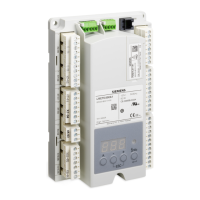LME Series Technical Instructions
Document No. LME-1000
SCC Inc. Page 1 Section 6
Introduction
The LME71 flame safeguard, when used with the PME71.901A1 program module, features an
integrated, closed-loop PWM (pulse width modulation) blower control. This integrated control is used
to modulate the speed of a PWM blower with firing rate. The LME71 transmits a PWM control signal to
the blower, and then reads back the speed of the blower. On most PWM blowers, the speed feedback
signal is taken from Hall Effect sensors that commutate the PWM blower motor.
Blower speed has a large impact on the air flow delivered to the burner, and thus has a large impact on
the fuel-air ratio. A combustion air pressure switch offers only a small amount of protection, since the
switch must be set to allow low fire operation when the PWM blower is spinning slowly and the blower
output pressure is low. Blower speed feedback ensures that a blower failure will be quickly detected
and the burner will shut down safely.
PWM Blower Fundamentals
A common type of variable speed blower is the brushless DC blower, commonly referred to as a PWM
blower. These blowers typically have a variable speed drive and a DC brushless motor integrated into
one housing. These blowers are typically fed single-phase or three-phase AC voltage directly, and use
some type of AC to DC rectification to produce the DC voltage pulses necessary to drive the blower
motor.
Unlike a brushed DC motor, field windings in a brushless motor are triggered (commutated) via non-
contact Hall Effect sensors. In addition to commutating the motor, these Hall Effect sensors also provide
a pulsed output that the LME7 can use for blower speed feedback. Wiring of the speed feedback signal
is covered in Section 2.
Brushless DC motors usually do not have the same speed limitations as most three-phase blower motors
do. While most three-phase blower motors are limited to about 3,800 RPM, some brushless DC motors
used in blower applications will spin in excess of 8,000 RPM. This high-speed capability is attractive in a
blower application since more air flow at higher pressures can be generated with a smaller blower. The
LME7 can read blower speeds up to 9,000 RPM via the Hall Effect sensors in the blower.
Accurate speed control of a brushless DC motor can be more challenging as compared to a VFD and a
three-phase AC motor. The primary reasons behind this are the electromechanical characteristics of the
motors themselves. In brushless DC motors, the motor windings are being fed DC pulses of variable
duration (hence these blowers being called pulse width modulation). The width of these pulses
determines the blower’s speed for a given torque output and for a given blower input voltage. All three
of these variables – pulse width, torque output, and input voltage have a substantial impact on the
blower’s speed and can be regarded as primary variables.
Some PWM blowers have internal speed controls that compensate for torque output and input voltage
variances. This is done by taking a commanded speed set point (dictated by the LME7) and adjusting the
width of the pulse to achieve the commanded speed. PWM blowers having fast updating, properly
tuned internal speed controls typically work well with the LME7.

